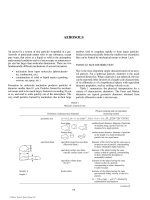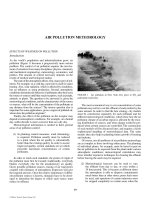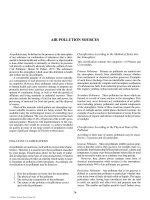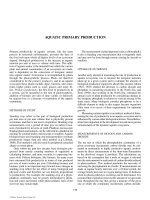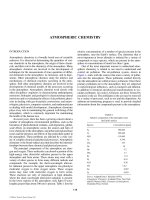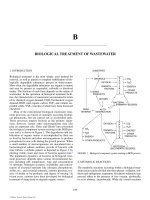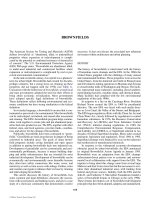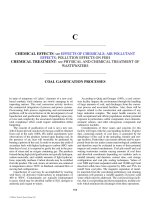ENCYCLOPEDIA OF ENVIRONMENTAL SCIENCE AND ENGINEERING - ECOSYSTEM THEORY potx
Bạn đang xem bản rút gọn của tài liệu. Xem và tải ngay bản đầy đủ của tài liệu tại đây (367.71 KB, 11 trang )
260
ECOSYSTEM THEORY
The concept of the ecosystem is not only the center of
professional ecology today, but it is also the most relevant
concept in terms of man’s environmental problems. During
the mid 70s, the public seized on the root meaning of ecology,
namely “oikos” or “house,” to broaden the subject beyond its
previously rather narrow academic confines to include the
“totality of man and environment,” or the whole environ-
mental house, as it were. We are witnessing what is called
a historic “attitude revolution” (Odum, 1969, 1970c) in the
way people look at their environment for the very simple
reason that for the first time in his short history man is faced
with ultimate rather than merely local limitations. It will be
well for all of us to keep this overriding simplicity in mind as
we face the controversies, false starts and backlashes that are
bound to accompany man’s attempts to put some negative
feedback into the vicious spiral of uncontrolled growth and
resource exploitation that has characterized the past several
decades.
Man has been interested in ecology in a practical sort
of way since early in his history. In primitive society every
individual, to survive, needed to have definite knowledge
of his environment, i.e., of the forces of nature and of the
plants and animals around him. Civilization, in fact, began
when man learned to use fire and other tools to modify his
environment. It is even more necessary than ever for man-
kind, as a whole, to have an intelligent knowledge of the
environment if our complex civilization is to survive, since
the basic “laws of nature” have not been repealed; only their
complexion and quantitative relations have changed, as the
world’s human population has increased and as man’s power
to alter the environment has expanded.
Like all phases of learning, the science of ecology has
had a gradual, if spasmodic, development during recorded
history. The writings of Hippocrates, Aristotle, and other
philosophers of the Greek period contain material which is
clearly ecological in nature. However, the Greeks literally
did not have a word for it. The word “ecology” is of recent
coinage, having been first proposed by the German biologist
Ernst Haeckel in 1869. Before this, many of the great men of
the biological renaissance of the eighteenth and nineteenth
centuries had contributed to the subject even though the
label “ecology” was not in use. For example, Anton von
Leeuwenhoek, best known as a pioneer microscopist of the
early 1700s, also pioneered the study of “food chains” and
“population regulation” (see Egerton, 1968), two impor-
tant areas of modern ecology. As a recognized distinct field
of biology, the science of ecology dates from about 1900,
and only in the past decade has the word become part of
the general vocabulary. Today, everyone is acutely aware of
the environmental sciences as indispensable tools for cre-
ating and maintaining the quality of human civilization.
Consequently, ecology is rapidly becoming the branch of
science that is most relevant to the everyday life of every
man, woman, and child.
As recently as 1960 the theory of the ecosystem was
rather well understood but not in any way applied. The
applied ecology of the 1960s consisted of managing compo-
nents as more or less independent units. Thus we had forest
management, wildlife management, water management,
soil conservation, pest control, etc., but no ecosystem man-
agement and no applied human ecology. Practice has now
caught up with theory. Controlled management of the human
population together with the resources and the life support
system on which it depends as a single, integrated unit now
becomes the greatest, and certainly the most difficult, chal-
lenge ever faced by human society.
As we have seen, an “anthropocentric” definition of
the ecosystem might read something as follows: Man as a
part of, not apart from, a life support system composed of
the atmosphere, water, minerals, soil, plants, animals, and
microorganisms that function together to keep the whole
viable.
Any unit including all of the organisms (i.e., the “com-
munity”) in a given area interacting with the physical envi-
ronment so that a flow of energy leads to a clearly defined
trophic structure, biotic diversity and material cycles (i.e.
exchange of materials between living and nonliving parts)
within the system is an ecological system or ecosystem.
The following formal definition is the one used in the
third edition of Fundamentals of Ecology (E.P. Odum, 1971)
The word ecology is derived from the Greek oikos, meaning
“house” or “place to live.” Literally, ecology is the study of
organisms “at home.” Usually ecology is defined as the study
of the relation of organisms or groups of organisms to their
environment, or the science of the interrelations between living
organisms and their environment. Because ecology is con-
cerned especially with the biology of groups of organisms and
with functional processes on the lands, in the oceans, and in
fresh waters, it is more in keeping with the modern emphasis
to define ecology as the study of the structure and function of
nature, it being understood that mankind is a part of nature.
© 2006 by Taylor & Francis Group, LLC
ECOSYSTEM THEORY 261
One of the definitions in Webster’s Unabridged Dictionary
seems especially appropriate for the closing decades of the 20th
century, namely, “ the totality or pattern of relations between
organisms and their environment. ” In the long run the best defi-
nition for a broad subject field is probably the shortest and least
technical one, as for example, “environmental biology.”
To understand the scope and relevance of ecology, the
subject must be considered in relation to other branches of
biology and to “ ologies ” in general. In the present age of
specialization in human endeavors, the inevitable connec-
tions between different fields are often obscured by the large
masses of knowledge with the fields (and sometimes also,
it must be admitted, by stereotyped college courses). At
the other extreme, almost any field of learning may be so
broadly defined as to take in an enormous range of subject
material. Therefore, recognized “fields” need to have recog-
nized bounds, even if these bounds are somewhat arbitrary
and subject to shifting from time to time. A shift in scope has
been especially noteworthy in the case of ecology as gen-
eral public awareness of the subject has increased. To many,
“ecology” now stands for “the totality of man and environ-
ment.” But first let us examine the more traditional academic
position of ecology in the family of sciences.
For the moment, let us look at the divisions of biology,
“the science of life.” Morphology, physiology, genetics, ecol-
ogy, evolution, molecular biology, and developmental biol-
ogy are examples of such divisions. We may also divide the
subject into what may be called “taxonomic” divisions, which
deal with the morphology, physiology, ecology, etc., of spe-
cific kinds of organisms. Zoology, botany, and bacteriology,
are large divisions of this type, and phycology, protozo-ology,
mycology, entomology, ornithology, etc., are divisions deal-
ing with more limited groups of organisms. Thus ecology is a
basic division of biology and, as such, as also an integral part
of any and all of the taxonomic divisions. Both approaches are
profitable. It is often very productive to restrict work to cer-
tain taxonomic groups, because different kinds of organisms
require different methods of study (one cannot study eagles by
the same methods used to study bacteria) and because some
groups of organisms are economically or otherwise much
more important or interesting to man than others. Ultimately,
however, unifying principles must be delimited and tested if
the subject field is to qualify as “basic.”
Perhaps the best way to delimit modern ecology is to
consider it in terms of the concept of levels of organization
visualized as a sort of “biological spectrum.” Community,
population, organization, organ cell, and gene are widely
used terms for several major biotic levels.
Interaction with the physical environment (energy and
matter) at each level producing characteristic functional
systems. By a system we mean just what Webster’s College
Dictionary defines as “regularly interacting and interde-
pendent components forming a unified whole.” Systems
containing living components (biological systems or biosys-
tems) may be conceived at any level in the hierarchy. For
example, we might consider not only gene systems, organ
systems, and so on, but also host-parasite systems as inter-
mediate levels between population and community.
HISTORICAL REVIEW OF THE ECOSYSTEM
CONCEPT
Although the term ecosystem was first proposed by the
British ecologist, A.G. Tansley in 1935, the concept is by no
means so recent. Allusions to the idea of the unity of organ-
isms and environment (as well as the oneness of man and
nature) can be found as far back in written history as one
might care to look, and such an idea has been a basic part
of many religions (less so in Christian religions as recently
pointed out by historian Lynn White, 1967). Anthropologists
and geographers have long been concerned with the impact
of man on his environment and early debated the question: To
what extent has man’s continuing trouble with deteriorated
environments stemmed from the fact that human culture
tends to develop independently of the natural environment?
The Vermont prophet George Perkins Marsh wrote a classic
treatise on this theme in 1864. He analyzed the causes of the
decline of ancient civilizations and forecast a similar doom
for modern ones unless “man takes what we would call today
an ecosystematic” view of man and nature. In the late 1800s
biologists began to write essays on the unity of nature, inter-
esting enough in a parallel manner in German, English, and
Russian languages. Thus Karl Möbius in 1877 wrote about
the community of organisms in an oyster reef as a “biocoe-
nosis,” while in 1887 the American S. A. Forbes wrote his
classic essay on “The Lake as a Microcosm.” The Russian
pioneering ecologist V. V. Dokuchaev (1846–1903) and his
disciple G. F. Morozov (who specialized in forest ecology)
placed great emphasis on the concept of “biocoenosis,”
a term later expanded to geobiocoenosis (or biogeocoenosis)
of the word “ecosystem.”
No one has expressed the relevance of the ecosystem
concept to man better than Aldo Leopold in his essays on
the land ethic. In 1933 he wrote: “Christianity tries to inte-
grate the individual to society, Democracy to integrate social
organization to the individuals. There is yet no ethic dealing
with man’s relation to the land” … which is “still strictly
economic entailing privileges but not obligations.” Thus,
man is continually striving, with but partial success so far,
to establish ethical relationships between man and man, man
and government, and, now, man and environment. Without
the latter what little progress has been made with the other
two ethics will surely be lost. In the context of the 1970
scene Garrett Harden (1968) says it in another way when he
points out that technology alone will not solve the popula-
tion and pollution dilemmas; ethical and legal constraints are
also necessary. Environmental science is now being called
upon to help determine a realistic level of human popula-
tion density and rate of use of resources and power that are
optimum in terms of the quality of human life, in order that
“societal feedback” can be applied before there are serious
overshoots. This requires diligent study of ecosystems, and,
ultimately, a judgment on the carrying capacity of the bio-
sphere. If studies of natural populations have any bearing
on the problem, we can be quite certain that the optimum
density in terms of the individual’s options for liberty and
© 2006 by Taylor & Francis Group, LLC
(see Sukachev, 1944), which can be considered a synonym
262 ECOSYSTEM THEORY
the pursuit of happiness is something less than the maximum
number that can be sustained at a subsistence level, as so
many domestic “animals” in a polluted feed lot!
My advanced ecology class recently attempted to deter-
mine what might be the optimum population for the State of
Georgia on the assumption that someday the state would have
to have a balanced resource input-output (i.e., live within its
own resources). On the basis of a per capita approach to land
use the tentative conclusion was that a density of one person
per five acres (2 hectares) represented the upper limit for
an optimum population size when the space requirements
for quality (i.e., high protein) food production, domestic ani-
mals, outdoor recreation, waste treatment and pollution-free
living space were all fully considered. Anything less than
five acres of live support and resource space per capita, it
was concluded, would result in a reduction in the individual
person’s options for freedom and the pursuit of happiness,
and, accordingly, a rapid loss in environmental quality. Since
the 1970 per capita density of Georgia is 1 in 8 acres and
for the United States as a whole, 1 in 10 acres no more than
double the present US population could be considered opti-
mum according to this type of analysis. This would mean
that we have about 30 years to level off population growth.
The study also suggested that permanent zoning of at least
one-third of land and freshwater areas (plus all estuarine and
marine zones) as “open space” in urbanizing areas would go
a long way toward preventing overpopulation, overdevelop-
ment and social decay that is now so evident in many parts
of the world today. The results of this preliminary study
have been published (E. P. Odum, 1970b). See also the pro-
edited by Taylor (1970).
THE TWO APPROACHES TO ECOSYSTEM STUDY
G. Evelyn Hutchinson in his 1964 essay, “The Lacustrine
Microcosm Reconsidered,” contrasts the two long-standing
ways ecologists attempt to study lakes or other large eco-
systems of the real world. Hutchinson cites E. A. Birge’s
(1915) work on heat budgets of lakes as pioneering the holo-
logical (from holos ϭ whole) or holistic approach in which
the whole ecosystem is treated as a “black box” (i.e., a unit
whose function may be evaluated without specifying the
internal contents) with emphasis on inputs and outputs, and
he contrasts this with the merological (from meros ϭ part)
approach of Forbes in which “we discourse on parts of the
system and try to build up the whole from them.” Each pro-
cedure has obvious advantages and disadvantages and each
leads to different kinds of application in terms of solving
problems. Unfortunately, there is something of a “credibility
gap” between the two approaches. As would be expected,
the merological approach has dominated the thinking of
the biologist-ecologist who is species-oriented, while the
physicist-ecologist and engineer prefer the “black box”
approach. Most of all, man’s environmental crisis has speeded
up the application of systems analysis to ecology. The for-
malized, or mathematical model, approach to populations,
communities, and ecosystems has come to be known as
systems ecology which is rapidly becoming a major science
in its own right for two reasons: (1) extremely powerful new
formal tools are now available in terms of mathematical theory,
cybernetics, electronic data processing, etc. (2) Formal sim-
plication of complex ecosystems provides the best hope for
solutions of man’s environmental problems that can no longer
be trusted to trial-and-error, or one-problem one- solution pro-
cedures that have been chiefly relied on in the past.
Again we see the contrast between merological and
holological approaches in that there are systems ecologists
who start at the population or other component level and
“model up,” and those who start with the whole and “model
down.” The same dichotomy is evident in the very rewarding
studies of experimental laboratory ecosystems. One class of
microecosystems can be called “derived” systems because
they are established by multiple seeding from nature in
contrast to “defined” microcosms which are built up from
previously isolated pure cultures. Theoretically, at least, the
approaches are applicable to efforts to devise life support
systems for space travel. In fact, one of the best ways to
visualize the ecosystems concept for students and laymen is
to consider space travel, because when man leaves the bio-
sphere he must take with him a sharply delimited enclosed
environment that will supply all vital needs with sun energy
as the only usable input from the surrounding very hostile
space environment. For journeys of a few weeks (such as
to the moon and back), man does not need a regenerative
ecosystem, since sufficient oxygen and food can be stored
while CO
2
and other waste products can be fixed or detoxi-
fied for short periods of time. For long journeys man must
engineer himself into a complete ecosystem that includes the
means of recycling materials and balancing production, con-
sumption and decomposition by biotic components or their
mechanical substitutes. In a very real sense the problems of
man’s survival in an artificial space craft are the same as
the problems involved in his continued survival on the earth
space ship. For example, detection and control of air, and
water pollution, adequate quantity and nutritional quality
of food, what to do with accumulated toxic wastes and gar-
bage, and the social problems created by reduced living
space are common concerns of cities and spacecrafts. For
this reason the ecologist would urge that national and inter-
national space programs now turn their attention to the study
and monitoring of our spaceship earth. As was the case with
Apollo 13, survival becomes the mission when the limits of
carrying capacity are approached.
THE COMPONENTS OF THE ECOSYSTEM
From the standpoint of trophic energy an ecosystem has two
components which are usually partially separated in space
and time, namely, an autotrophic component (autotrophic ϭ
self nourishing) in which fixation of light energy, use of
simple inorganic substances, and the buildup of complex sub-
stances predominate; and secondly, a heterotrophic compo-
nent (heterotrophic ϭ other-nourshing) in which utilization,
© 2006 by Taylor & Francis Group, LLC
vocative symposium on The Optimum Population for Britain
ECOSYSTEM THEORY 263
rearrangement and decomposition of complex materials
predominate. As viewed from the side (cross section) eco-
systems consist of an upper “green belt” which receives
incoming solar energy and overlaps, or interdigitates, with
a lower “brown belt” where organic matter accumulates and
decomposes in soils and sediments.
It is convenient for the purposes of first order analysis
and modelling to recognize six structural components and
six processes as comprising the ecosystem as follows:
A. Components
1) Inorganic substances (C, N, CO
2
, H
2
O, etc.)
involved in material cycles.
2) Organic compounds (proteins, carbohydrates,
lipids, humic substances, etc.) that link biotic and
abiotic.
3) Climate regime (temperature, rainfall, etc.).
4) Autotrophs or producers, largely green plants able
to manufacture food from simple substances.
5) Phagotrophs (phago ϭ to eat) or macro-consumers,
heterotrophic organisms, largely animals which
ingest other organisms or particulate organic
matter.
6) Saprotrophs (sapro ϭ to decompose) or micro-
consumers (also called osmotrophs), heterotro-
phic organisms, chiefly bacterial, fungi, and some
protozoa that break down complex compounds,
absorb some of the decomposition products and
release inorganic substances usable by the auto-
trophs together with organic residues which may
provide energy sources or which may be inhibitory,
stimulatory or regulatory to other biotic compo-
nents of the ecosystem.
(Another useful division for heterotrophs: biophages ϭ
organisms that feed on other living organisms; saprophages ϭ
organisms that feed on dead organic matter.)
B. Processes
1) Energy flow circuits.
2) Foods chains (trophic relationships).
3) Diversity patterns in time and space.
4) Nutrient (biogeochemical) cycles.
5) Development and Evolution.
6) Control (cybernetics).
Subdivision of the ecosystem into these six “compo-
nents” and six “processes,” as with most classification, is
arbitrary but convenient, since the former emphasize struc-
ture and the latter function. From the holistic viewpoint, of
course, components are operationally inseparable. While
different methods are often required to delineate structure
on the one hand and to measure rates of function on the
other, the ultimate goal of study at any level or organiza-
tion is to understand the relationship between structure and
function. It is not feasible to go into any detailed discussion
of these component-processes in this brief introduction (one
can refer to textbooks and review papers), but we can list
a few key principles that are especially relevant to human
in picturing the basic arrangement and functional linkage of
ecosystem components.
1) The living (items A4–6 above) and non-living
(items A1–3) parts of ecosystems are so inter-
woven into the fabric of nature that it is difficult
to separate them, hence operational classifica-
tions (B1–6) do not make a sharp distinction
between biotic and abiotic. Elements and com-
pounds are in a constant state of flux between
living and non-living states. There are very few
substances that are confined to one or the other
state. Exceptions may be ATP which is found
only inside living cells, and humic substances
(resistant end-products of decomposition) which
are not found inside cells yet are characteristic of
all ecosystems.
2) The time-space separation of autotrophic and het-
erotrophic activity leads to a convenient classifi-
cation of energy circuits into (1) a grazing food
chain (where term grazing refers to direct con-
sumption of living plants or plant parts) and (2) an
organic detritus (from deterere = to wear away)
food chain which involves the accumulation and
decomposition of dead materials. To build up a
stable biomass structure there must be negative
feedback control of grazing—a need too often
neglected in man’s domesticated ecosystems.
3) As in well known available energy declines with
each step in the food chain (so a system can sup-
port more herbivores than carnivores; if man
wants to keep his meat-eating option open there
will have to be fewer people supported by a given
food base). On the other hand, materials often
become concentrated with each step in the food
chains. Failure to anticipate possible “biologi-
cal magnification” of pollutants, such as DDT or
long-lived radionuclides, is causing serious prob-
lems in man’s environment.
4) It is becoming increasingly evident that high bio-
logical productivity (in terms of calories per unit
area) in both natural and agricultural ecosystems
is almost always achieved with the aid of energy
subsidies from outside the system that reduces the
cost of maintenance (thus diverting more energy
to production). Energy subsidies take the form of
wind and rain in a rain forest, tidal energy in an
estuary (see Figure 1), or fuel, animal or human
work energy used in the cultivation of a crop. In
comparing productivity of different systems it is
important to consider the complete budget —not
just light input.
5) Likewise it is increasingly evident that both har-
vest and pollution are stresses which reduce the
© 2006 by Taylor & Francis Group, LLC
ecology. Figure 1 is a schematic diagram that may be useful
264 ECOSYSTEM THEORY
energy available for self-maintenance. Man must
be aware that he will have to pay the costs of added
anti-thermal maintenance, or “disorder pumpout,”
as H. T. Odum, 1971 (Chapter 5) calls it. It is dan-
gerous strategy to try to force too much produc-
tivity, or yield, from the landscape (as is being
attempted in the so-called “green revolution”)
because very serious “ecological back-lashes”
can result from the following (1) pollution caused
by heavy use of fertilizers and insecticides and the
consumption of fossil fuels, (2) unstable or oscil-
lating conditions created by one-crop systems,
(3) vulnerability of plants to disease because their
self-protection mechanisms have been “selected
out,” in favor of yield, and (4) social disorder cre-
ated by rapid shift of rural people to cities that
C. ENERGY FLOW
ORGANIC
MATTER
LIGHT
CIRCULATION WORK
A. VERTICAL ZONES
ENERGY TRANSFER
WORK GATE
B. MINERAL CYCLE
BOTTOM
CONSUMERS
POOL OF
NUTRIENTS
FOR PLANT
GROWTH
EXPORT
EXPORT
EXPORT
IMPORT
SEDIMENT SUBSYSTEM
WORMS, CLAMS, BACTERIA, ETC.
IMPORT
IMPORT
PLANT
CELL
ORGANIC STORAGE
CONSUMERS
CONSUMERS
PRODUCERS
EUPHOTIC
(AUTOTROPHIC)
SUBSYSTEM
WATER COLUMN SUBSYSTEM
ZOOPLANKTON AND
SWIMMING CONSUMERS
(FISH, ETC.)
SUN LIGHT
R
R
RP
R
RECYCLING
PRODUCERS
CONSUM-
ERS
TIDE
&
WAVES
FIGURE 1 Three aspects of the structure and function of ecosystems as illustrated by an estuarine system. A. Vertical zonation with
photosynthetic production above (autotrophic stratum) and most of the respiration and decomposition below (heterotrophic stratum).
B. Material cycle with circulation of plant nutrients upward and organic matter food downward. C. Energy flow circuit diagram showing three
sources of energy input into the system. The bullet-shaped modules represent producers with their double metabolism, that is P (production)
and R (respiration). The hexagons are populations of consumers which have storage, self maintenance and reproduction. The storage bins
represent nutrient pools in and out of which move nitrogen, phosphorous and other vital substances. In diagrams B and C the lines represent
the “invisible wires of nature” that link the components into a functional network. In diagram C the “ground” symbols (i.e., arrow into the heat
sink) indicate where energy is dispersed and no longer available in the food chain. The circles represent energy inputs. The work gate symbols
(large X) indicate where a flow of work energy along one pathway assists a second flow to pass over energy barriers. Note that some of
the lines of flow loop back from “downstream” energy sources to “upstream” inflows serving various roles there including control functions
(saprotrophs controlling photosynthesis by controlling the rate of mineral regeneration, for example). The diagram (C) also shows how auxil-
liary energy of the tide (energy subsidy) assists in (1) recycling of nutrients from consumer to producer and (2) speeding up the movement
of plant food to the consumer. Reducing tidal flow by dyking the estuary will reduce the productivity just as surely as cutting out some of the
light. Stress such as pollution or harvest can be shown in such circuit models by adding circles enclosing negative signs linked with appropri-
ate heat sinks to show where energy is diverted away from the ecosystem. Both subsidies (ϩ) and stress (Ϫ) can be quantitated in terms of
Calories added or diverted per unit of time and space. (From E.P. Odum, 1971 after H.T. Odum, and B.J. Copeland, 1969.)
© 2006 by Taylor & Francis Group, LLC
ECOSYSTEM THEORY 265
are not prepared to house or employ them (the
tragedy here is that industrialized agriculture can
result in increased food per acre but it can also
widen the gap between rich and poor so that there
are increasing numbers of people unable to buy
the food!).
6) While we generally think of production and decom-
position as being balanced on the biosphere as
a whole, the truth is that this balance has never
been exact but has fluctuated from time to time in
geological history. Through the long haul of evo-
lutional history production has slightly exceeded
decomposition so that a highly oxygenic atmo-
sphere has replaced the original reducing atmo-
sphere of the earth. Man, of course, is tending to
reverse this trend by increasing, decomposition
(burning of fuels, etc.) at the expense of produc-
tion. The most immediate problem is created by
the increase in atmospheric CO
2
since relatively
small changes in concentration can have large
effects on the heat budget of the earth.
7) Ecological studies indicate that diversity is directly
correlated with stability and perhaps inversely
correlated with productivity, at least in many situ-
ations. It could well be that the preservation of
diversity in the ecosystem is important for man
since variety may be a necessity, not just the spice
of life!
8) At the population level it is now clear that the
growth form of the human population will not
conform to the simple sigmoid or logistic model
since there will always be a long time lag in the
effects of crowding, pollution and overexploita-
tion of resources. Growth will not “automatically”
level off as do populations of yeasts in a confined
vessel where individuals are immediately affected
by their waste products. Instead, the human popu-
lation will clearly overshoot some vital resource,
unless man can “anticipate” the effects of over-
population and reduce growth rates before the
deleterious effects of crowding are actually felt.
Intelligent reasoning behavior seems now to be
Protista
Monera
Ciliophora
Sarcodina
Porifera
Ingestion
C
o
ele
nte
ra
ta
Chaetognatha
Echinodermata
Chordata
Arthropoda
M
oll
us
ca
Annelida
Absorption
Te ntoculata
Aschelminthes
Platyhelminthes
Mesozoa
Photosynthesis
Hyphochytridiomycoid
Plasmodiophoremycoid
Sporozoa
Z
o
o
m
a
s
t
i
g
i
n
a
C
n
i
d
o
s
p
o
r
i
d
i
a
M
y
a
o
m
y
c
o
t
a
A
c
r
a
s
i
o
m
y
c
o
t
a
L
a
b
y
r
i
n
t
h
y
l
o
m
y
c
o
t
a
Animalia
Fungi
Plantae
B
a
c
t
e
r
i
a
C
y
a
n
o
p
h
y
t
a
Euglenophyta
Chr
ysophyta
Pyrrophyta
Zygomycota
Basidiomycota
Ascomycota
Oomycota
C
h
y
t
r
i
d
i
o
m
y
c
o
t
a
Trocheophyta
Bryophyta
Phoeophyta
Charophyta
Chlorophyta
Rhodophyta
FIGURE 2 A five-kingdom system based on three levels of organization—the
procaryotic (kingdom Monera), apearyotic unicelluar (kingdom Protista), and eucary-
otic multicelluar and multinucleate. On each level there is divergence in relation to
three principal modes of nutrition—the photosynthetic, absorptive, and ingestive. Many
ecology and microbiology texts list four kingdoms by combining the “lower Protista”
(i.e., Monera) with the higher “Protista” to form “Protista.” Evolutionary relations are
much simplified, particularly in the Protista. Only major animal phyla are entered,
and phyla of the bacteria are omitted. The Coelenterata comprise the Cnidaria and
Ctenophora; the Tentaculata comprise the Bryozoa, Brachiopoda, and Phoronida, and in
some treatments the Batoprocta. (From Whittaker, 1969.)
© 2006 by Taylor & Francis Group, LLC
I
II A
II B
III-1A
III-1A
III-1B
III 2
III 2
III-3
IV
SUN
ENERGY
FIGURE 3 Diagram of the pond ecosystem. Basic units are as follows? I, abiotic substances—basic inorganic and organic
compounds; IIA, producers—rooted vegetation; IIB, producers-phytoplankton; III-1A, primary consumers (herbivores)—
bottom forms; III-1B, primary consumers (herbivores)—zooplankton; III-2, secondary consumers (carnivores); III-3, tertiary
consumers (secondary carnivores); IV, saprotrophs—bacteria and fungi of decay. The metabolism of the system runs on sun
energy, while the rate of metabolism and relative stability of the pond depend on the rate of inflow of materials from rain and
from the drainage basin in which the pond is located. (From Odum, 1971.)
266 ECOSYSTEM THEORY
© 2006 by Taylor & Francis Group, LLC
ECOSYSTEM THEORY 267
FIGURE 4 Schematic design for a waste management park for the atomic power plant (PP) of the future which is located in a natural
watershed basic (outlined by the dashed lines). Waste heat (i.e., thermal pollution) in the reactor cooling water (CW) flowing from a large
storage reservoir (R) is completely dissipated by evaporative cooling from the network of shallow ponds and spray irrigation systems.
The warm ponds may be used for fish culture, sport fishing, or other recreation purposes. Irrigation of portions of the terrestrial watershed
increases the yield of useful forest or agricultural products, while at the same time water recycles through the “living filter” of the land back
into stream, ponds, and ground-water. Low-level nuclear wastes and solid wastes are contained within carefully managed land fill area (W);
high-level nuclear wastes in spent fuel elements are exported to a special nuclear burial ground located outside of the management part.
Stream flow, ground water, and stack gases are continuously monitored by hydrological weirs (HW), monitoring wells (MW), and stack
gas control systems (SG) in order to make certain that no air or water pollution leaves the controlled area. The chief inputs and outputs for
this environmental system include (see numbered marginal arrows): 1, input of sunlight and rainfall; 2, export of nuclear wastes to burial
grounds; 3, electric power to cities, etc.; 4, input of nuclear and other fuels; 5, output of food, fibres, clean air, etc.; 6. downstream flow of
clean water for agriculture, industry, and cities; 7, public and professional use for recreation, education, and environmental research. The
size of such a complete waste management park will depend on regional climates and topography, and on the amount of electrical or other
energy diverted to power cooling, but something on the order of 10,000 acres for a 2500 megawatt power plant would be the minimum
needed to insure 100% pollution control and allow for accidents and mechanical malfunctions. However, such waste treatment capacity
could also support a certain amount of light industry within the park. Heavy industry should be located within its own waste management
park. (From Odum, 1971).
© 2006 by Taylor & Francis Group, LLC
268 ECOSYSTEM THEORY
FIGURE 5 Pollution of a stream with untreated sewage and the subsequent recovery as reflected in
changes in the biotic community. As the oxygen dissolved in the water decrease (curve to the left), fishes
disappear and only organisms able to obtain oxygen from the surface (as in Culex mosquito larvae) or those
which are tolerant of low oxygen concentration are found in zone of maximum organic decomposition.
When bacteria have reduced all of the discharged material the stream returns to normal. (After Eliassen,
Scientific American, Vol. 186, No. 3, March, 1952.)
© 2006 by Taylor & Francis Group, LLC
ECOSYSTEM THEORY 269
the only means to accomplish this, as emphasized
at the beginning of the article.
9) Some of the most important “breakthroughs”
in ecology are in the area of biogeochemical
cycling. Since “recycle” of water and minerals
must become a major goal of human society the
recycle pathways in nature are of great interest;
there seem to be at least four major ones which
vary in importance in different kinds of eco-
systems: (1) recycle via microbial decomposi-
tion of detritus, (2) recycle via animal excretion,
(3) direct recycle from plant back to plant via symbi-
otic microorganism such as mycorrhizae associated
with roots, and (4) autolysis, on chemical recycle,
with no organism involved. Pathway 3 seems to be
especially important in the humid tropics which
suggests tropical agriculture might be redesigned
to include plant foods with mycorrhizae.
10) The principles inherent in limiting factor analysis
and in human ecology can be combined to formu-
late the following tentative overview: In an indus-
trialized society energy (power, food) is not likely
to be limiting, but the pollution consequences of
the use of energy and exploitation of resources is
limiting. Thus, pollution can be considered the
limiting factor for industrialized man—which may
be fortunate since pollution is so “visible” that it
can force us to use that reasoning power which is
supposed to be a special attribute of man.
ECOSYSTEM DEVELOPMENT
Principles having to do with the development of ecosystems,
that is ecological succession, are among the most relevant
in view of man’s present situation. I have recently reviewed
this subject (Odum, 1970); accordingly a brief summary will
suffice for this piece.
In broad view ecosystems develop through a rapid
growth stage that leads to some kind of maturity or steady
state (climax), usually an oscillating steady state. The
early successional growth stage is characterized by a high
Production/respiration (P/R) ratio, high yields (net produc-
tion), short food chains, low diversity, small size of organ-
ism, open nutrient cycles and a lack of stability. In contrast,
mature stages have a high biomass/respiration (B/R) ratio,
food web, low net production, high diversity and stability.
In other words, major energy flow shifts from production to
maintenance (respiration).
The general relevance of the development sequence
to land use planning can be emphasized by the following
“mini-model” that contrasts in very general terms young and
mature ecosystems:
Young Mature
Production Protection
Growth Stability
Quantity Quality
It is mathematically impossible to obtain a maximum
for more than one thing at a time, so one can not have both
extremes at the same time and place. Since all six character-
istics are desirable in the aggregate, two possible solutions
to the dilemma suggest themselves. We can compromise
so as to provide moderate quality and moderate yield on
all the landscape, or we can plan to compartmentalize the
landscape so as to simultaneously maintain highly produc-
tive and predominantly protective types as separate units
subjected to different management strategies. If ecosystem
development theory is valid and applicable to land-use plan-
ning (total zoning), then the so-called multiple-use strategy,
about which we hear so much will work only through one or
both of these cases, because in most cases, projected multiple
uses conflict with one another. Some examples and sugges-
tions for implementing compartmental plans are considered
in the above mentioned paper.
REFERENCES
Birge, E.A. (1915), The heat budgets of American and European lakes,
Trans. Wis. Acad. Arts. Lett. 18, 166–213.
Cairns, J. Rehabilitating damaged ecosystems, CRC Press, Boca Raton,
1988.
Dokuchaev, V.V., Teaching about the zones of nature, (in Russian). Reprinted
1948, Moscow.
Forbes, S.A. (1887), The lake as a microcosm, Bull. Sc. H. Peoria, reprinted
in: Ill. Nat. Hist. Surv. Bull. 15, 537–550 (1925).
Hardin, G. (1968), The Tragedy of the commons, Science 162, 1243–1248.
Hutchinson, G.E. (1964), The lacustrine microcosm reconsidered, Amer.
Sci. 52, 331–341.
Jerrers, J.N.R., Practitioners handbook in the modelling of dynamic changes
in ecosystems, Wiley, Chichester, 1988.
Jorgensøn, S.E., Modelling the fate and effect of toxic substances in the
environment, Elsevier, Amsterdam, 1984.
Leopold, Aldo (1933), The conservation ethic, Jour. Forestry 31, 634–643.
MacArthur, R.H., Geographical ecology, Patterns in the distribution of spe-
cies, Princeton University Press, 1984.
Marsh, G.P. (1864), Man and Nature: or Physical Geography as
Modifed by Human Action, reprinted 1965 by Harvard Univ. Press,
Cambridge.
Mellos, K., Perspectives on ecology, Macmillan, Basingstoke, 1989.
Möbius, K. (1877), Die Auster und die Austernwirtschart. Berlin, Transl.
1880. Rept. U.S. Fish Comm., 1880, 683 to 751.
Odum, H.T. (1970), Environment, Power and Society, John Wiley and Sons,
N.Y., p. 331.
Odum, H.T. (1967), Biological circuits and the marine systems of Texas, in
Pollution and Marine Ecology (Olson and Burgess, Eds.), John Wiley
and Sons, N.Y., pp. 99–157.
Odum, H.T., B.J. Copeland, and E.A. McMahan (1969), Coastal Eco-
logical Systems of the United States. A report to the Federal Water
Pollution Control Administration, Marine Sci. Inst., Univ. Texas,
Mimeograph.
Odum, Eugene P. (1969), The attitude lag, BioScience 19, 403.
Odum, Eugene P. (1970a), The strategy of ecosystem development, Science,
164, 262–270.
Odum, E.P. (1970b), Optimum population and environment: A Georgia
microcosm, Current History 58, 355–359.
Odum, E.P. (1970c), The attitude revolution, in The Crisis of Survival,
Scott, Foresman Co., Glenview, Ill., pp. 9–15.
Odum, E.P. (1971), Fundamentals of Ecology, 3rd Edition, W.B. Saunders,
Philadelphia.
Polunin, N.V., Ecosystem theory and practice, Wiley, Chichester, 1986.
Sukachev, V.N. (1944), On principle of genetic classification in bioeoenol-
ogy, translated and condensed by F. Raney and R. Daubenmire. Ecol.
39, 364–367. (See also Silva Fennica, 105, 94, (1960)).
© 2006 by Taylor & Francis Group, LLC
270 ECOSYSTEM THEORY
EFFECTS OF AIR POLLUTANTS: see AIR POLLUTANT EFFECTS
Tansley, A.G. (1935), The use and abuse of vegetational concepts and terms,
Ecol. 16, 284–307.
Taylor, L.R. (Ed.), The Optimum Population for Britain, Academic Press,
N.Y., p. 182, 1970.
Walter, H. and S.W. Brecke, Ecological systems of the biosphere; Eco-
logical principles in global perspective (Ökologie der Erde), Springer
Verlag, Heidelberg, 1985.
White, L. (1967), The historical roots of our ecological crisis, Science 155,
1203–1207.
EUGENE P. ODUM
University of Georgia
© 2006 by Taylor & Francis Group, LLC

